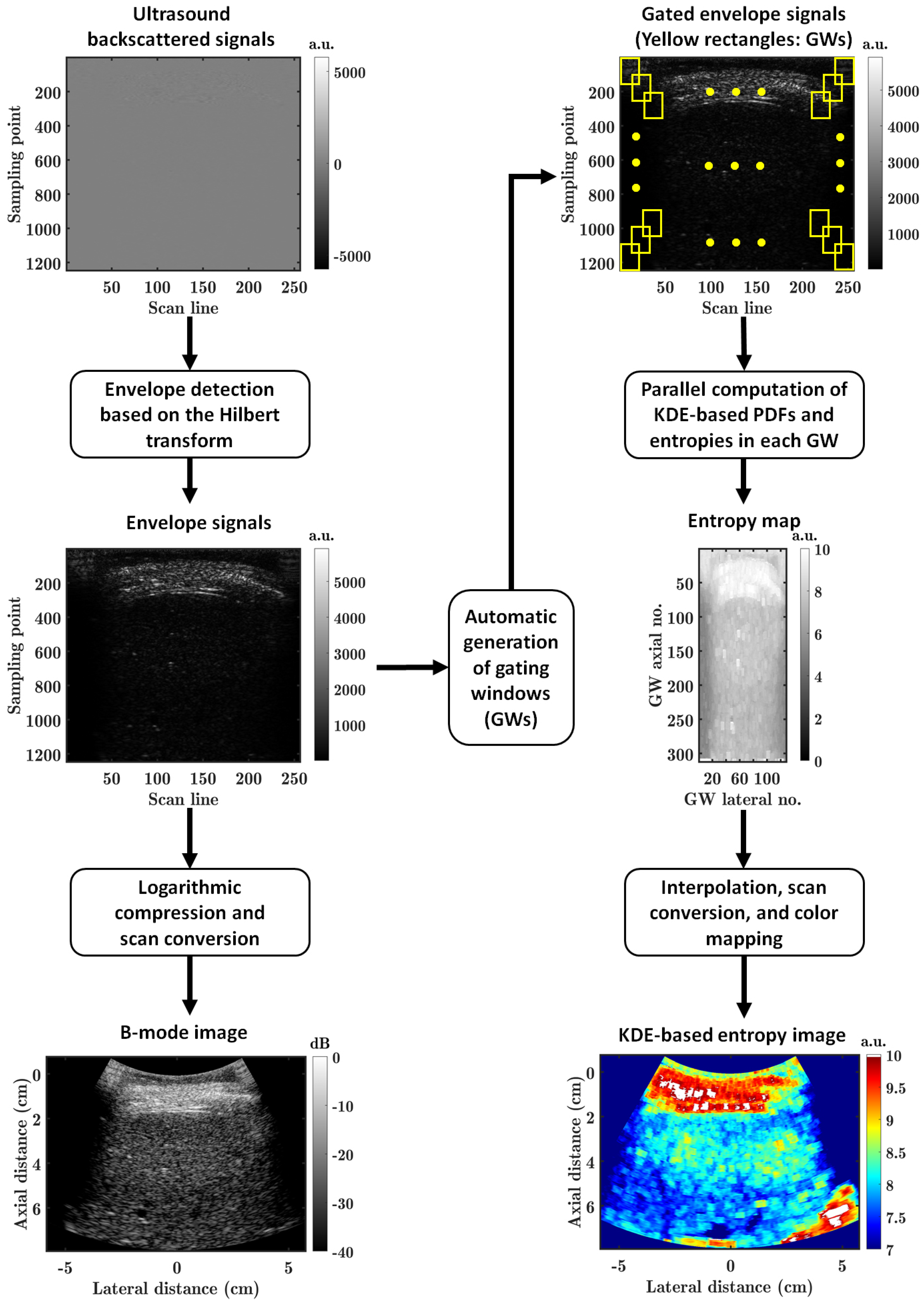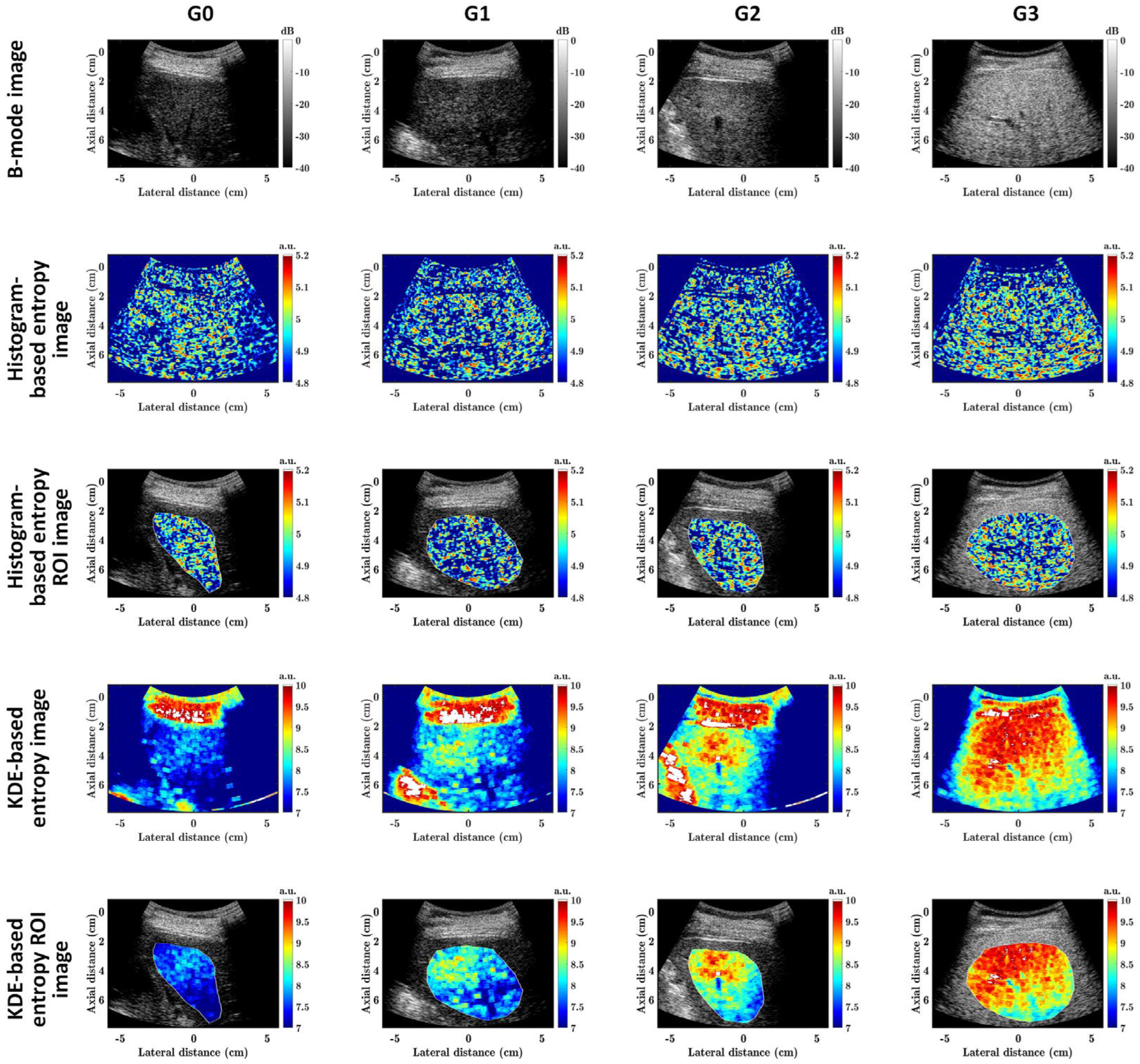Ultrasound Entropy Imaging Based on the Kernel Density Estimation: A New Approach to Hepatic Steatosis Characterization
Abstract
:1. Introduction
- (1)
- To the best of our knowledge, this study is the first to propose KDE-based ultrasound Shannon entropy imaging, which overcomes the drawbacks of conventional histogram-based ultrasound Shannon entropy imaging methods.
- (2)
- Parallelized computation techniques are incorporated to speed up the proposed algorithm.
- (3)
- Clinical validations of hepatic steatosis evaluation are performed.
2. Materials and Methods
2.1. KDE-Based Shannon Entropy Estimation of Ultrasound Backscattered Signals
2.2. KDE-Based Parallelized Ultrasound Shannon Entropy Imaging Method
2.3. Clinical Validations
2.4. Clinical Ultrasound Backscattered Signal Processing Method
2.5. Statistical Analysis
3. Results
4. Discussion
5. Conclusions
Author Contributions
Funding
Institutional Review Board Statement
Informed Consent Statement
Data Availability Statement
Acknowledgments
Conflicts of Interest
References
- Younossi, Z.; Tacke, F.; Arrese, M.; Chander Sharma, B.; Mostafa, I.; Bugianesi, E.; Wai-Sun Wong, V.; Yilmaz, Y.; George, J.; Fan, J.; et al. Global perspectives on nonalcoholic fatty liver disease and nonalcoholic steatohepatitis. Hepatology 2019, 69, 2672–2682. [Google Scholar] [CrossRef]
- Eslam, M.; Sanyal, A.J.; George, J.; Sanyal, A.; Neuschwander-Tetri, B.; Tiribelli, C.; Kleiner, D.E.; Brunt, E.; Bugianesi, E.; Yki-Järvinen, H.; et al. MAFLD: A consensus-driven proposed nomenclature for metabolic associated fatty liver disease. Gastroenterology 2020, 158, 1999–2014. [Google Scholar] [CrossRef] [PubMed]
- Rinella, M.E.; Lazarus, J.V.; Ratziu, V.; Francque, S.M.; Sanyal, A.J.; Kanwal, F.; Romero, D.; Abdelmalek, M.F.; Anstee, Q.M.; Arab, J.P.; et al. A multi-society Delphi consensus statement on new fatty liver disease nomenclature. J. Hepatol. 2023, 29, 101133. [Google Scholar] [CrossRef]
- Oelze, M.L.; Mamou, J. Quantitative Ultrasound in Soft Tissues, 2nd ed.; Springer: Cham, Switzerland, 2023; pp. 1–301. [Google Scholar]
- Cloutier, G.; Destrempes, F.; Yu, F.; Tang, A. Quantitative ultrasound imaging of soft biological tissues: A primer for radiologists and medical physicists. Insights Imaging 2021, 12, 127. [Google Scholar] [CrossRef] [PubMed]
- Yamaguchi, T. Basic Concept and clinical applications of quantitative ultrasound (QUS) technologies. J. Med. Ultrason. 2021, 48, 391–402. [Google Scholar] [CrossRef]
- Destrempes, F.; Cloutier, G. Review of envelope statistics models for quantitative ultrasound imaging and tissue characterization. In Quantitative Ultrasound in Soft Tissues; Oelze, M.L., Mamou, J., Eds.; Springer: Cham, Switzerland, 2013; pp. 219–274. [Google Scholar]
- Oelze, M.L.; Mamou, J. Review of quantitative ultrasound: Envelope statistics and backscatter coefficient imaging and contributions to diagnostic ultrasound. IEEE Trans. Ultrason. Ferroelectr. Freq. Control 2016, 63, 336–351. [Google Scholar] [CrossRef]
- Tsui, P.H. Information entropy and its applications. In Quantitative Ultrasound in Soft Tissues, 2nd ed.; Oelze, M.L., Mamou, J., Eds.; Springer: Cham, Switzerland, 2023; pp. 153–167. [Google Scholar]
- Han, M.; Song, W.; Zhang, F.; Li, Z. Modeling for quantitative analysis of Nakagami imaging in accurate detection and monitoring of therapeutic lesions by high-intensity focused ultrasound. Ultrasound Med. Biol. 2023, 49, 1575–1585. [Google Scholar] [CrossRef]
- Yang, G.; Zhang, S.; Li, X.; Shen, T.; Jia, X.; Ding, Y.; Zhang, B.; Wang, H.; Li, X.; Ren, P. A systemic study on the performance of different quantitative ultrasound imaging techniques for microwave ablation monitoring of liver. IEEE Trans. Instrum. Meas. 2023, 72, 5012511. [Google Scholar] [CrossRef]
- Chowdhury, A.; Razzaque, R.R.; Muhtadi, S.; Shafiullah, A.; Abir, E.U.I.; Garra, B.S.; Alam, S.K. Ultrasound classification of breast masses using a comprehensive Nakagami imaging and machine learning framework. Ultrasonics 2022, 124, 106744. [Google Scholar] [CrossRef]
- Wang, D.; Ma, Q.; Wang, Q.; Fan, Y.; Lu, S.; Su, Q.; Zhong, H.; Wan, M. Feasibility investigation of logarithmic Nakagami parametric imaging in recovering underestimated perfusion metrics of DCEUS in the uneven acoustic field. Med. Phys. 2022, 49, 2452–2461. [Google Scholar] [CrossRef]
- Destrempes, F.; Trop, I.; Allard, L.; Chayer, B.; Garcia-Duitama, J.; El Khoury, M.; Lalonde, L.; Cloutier, G. Added Value of Quantitative Ultrasound and Machine Learning in BI-RADS 4-5 assessment of solid breast lesions. Ultrasound Med. Biol. 2020, 46, 436–444. [Google Scholar] [CrossRef] [PubMed]
- Liu, Y.; Zhang, Y.; He, B.; Li, Z.; Lang, X.; Liang, H.; Chen, J. An improved parameter estimator of the homodyned K distribution based on the maximum likelihood method for ultrasound tissue characterization. Ultrason. Imaging 2022, 44, 142–160. [Google Scholar] [CrossRef] [PubMed]
- Zhou, Z.; Tai, D.I.; Wan, Y.L.; Tseng, J.H.; Lin, Y.R.; Wu, S.; Yang, K.C.; Liao, Y.Y.; Yeh, C.K.; Tsui, P.H. Hepatic steatosis assessment with ultrasound small-window entropy imaging. Ultrasound Med. Biol. 2018, 44, 1327–1340. [Google Scholar] [CrossRef] [PubMed]
- Karbalaeisadegh, Y.; Yao, S.; Zhu, Y.; Grimal, Q.; Muller, M. Ultrasound characterization of cortical bone using Shannon entropy. Ultrasound Med. Biol. 2023, 49, 1824–1829. [Google Scholar] [CrossRef] [PubMed]
- Li, P.; Yang, X.; Yin, G.; Guo, J. Skeletal muscle fatigue state evaluation with ultrasound image entropy. Ultrason. Imaging 2020, 42, 235–244. [Google Scholar] [CrossRef] [PubMed]
- Behnia, A.; Behnam, H.; Shaswary, E.; Tavakkoli, J. Thermometry using entropy imaging of ultrasound radio frequency signal time series. Inst. Mech. Eng. Part H J. Eng. Med. 2022, 236, 1502–1512. [Google Scholar] [CrossRef] [PubMed]
- Fang, J.; Ting, Y.; Chen, Y. Quantitative assessment of lung ultrasound grayscale images based on Shannon entropy for the detection of pulmonary aeration: An animal study. J. Ultrasound Med. 2022, 41, 1699–1711. [Google Scholar] [CrossRef]
- Li, X.; Jia, X.; Shen, T.; Wang, M.; Yang, G.; Wang, H.; Sun, Q.; Wan, M.; Zhang, S. Ultrasound entropy imaging for detection and monitoring of thermal lesion during microwave ablation of liver. IEEE J. Biomed. Health Inform. 2022, 26, 4056–4066. [Google Scholar] [CrossRef]
- Wu, X.; Lv, K.; Wu, S.; Tai, D.I.; Tsui, P.H.; Zhou, Z. Parallelized ultrasound homodyned-K imaging based on a generalized artificial neural network estimator. Ultrasonics 2023, 132, 106987. [Google Scholar] [CrossRef]
- Kapur, J.N.; Kesavan, H.K. Entropy Optimization Principles with Applications; Academic Press: San Diego, CA, USA, 1992; pp. 96–97. [Google Scholar]
- Smolíková, R.; Wachowiak, M.P.; Zurada, J.M. An information-theoretic approach to estimating ultrasound backscatter characteristics. Comput. Biol. Med. 2004, 34, 355–370. [Google Scholar] [CrossRef]
- Dudewicz, E.J.; Van der Meulen, E.C. The empiric entropy, a new approach to nonparametric entropy estimation. In New Perspectives in Theoretical and Applied Statistics; Puri, M.L., Vilaplana, J., Westz, W., Eds.; Wiley: New York, NY, USA, 1987; pp. 207–227. [Google Scholar]
- Scott, D.W. Multivariate Density Estimation: Theory, Practice, and Visualization; John Wiley & Sons: New York, NY, USA, 1992; pp. 152–154. [Google Scholar]
- Zhou, Z.; Zhang, Q.; Wu, W.; Lin, Y.H.; Tai, D.I.; Tseng, J.H.; Lin, Y.R.; Wu, S.; Tsui, P.H. Hepatic steatosis assessment using ultrasound homodyned-K parametric imaging: The effects of estimators. Quant. Imaging Med. Surg. 2019, 9, 1932–1947. [Google Scholar] [CrossRef] [PubMed]
- Huang, Y.; Wang, Z.; Liao, B.; Liang, J.-Y.; Zhou, L.-Y.; Wang, F.; Li, W.; Liu, J.-Y.; Xie, X.-Y.; Lu, M.-D.; et al. Assessment of liver fibrosis in chronic hepatitis B using acoustic structure quantification: Quantitative morphological ultrasound. Eur. Radiol. 2016, 26, 2344–2351. [Google Scholar] [CrossRef]
- Brunt, E.M.; Janney, C.G.; Di Bisceglie, A.M.; Neuschwander-Tetri, B.A.; Bacon, B.R. Nonalcoholic steatohepatitis: A proposal for grading and staging the histological lesions. Am. J. Gastroenterol. 1999, 94, 2467–2474. [Google Scholar] [CrossRef] [PubMed]
- Tandra, S.; Yeh, M.M.; Brunt, E.M.; Vuppalanchi, R.; Cummings, O.W.; Ünalp-Arida, A.; Wilson, L.A.; Chalasani, N. Presence and significance of microvesicular steatosis in nonalcoholic fatty liver disease. J. Hepatol. 2011, 55, 654–659. [Google Scholar] [CrossRef] [PubMed]
- Hughes, M.S. Analysis of digitized waveforms using Shannon entropy. J. Acoust. Soc. Am. 1993, 93, 892–906. [Google Scholar] [CrossRef]
- Larrue, A.; Noble, J.A. Nakagami imaging with small windows. In Proceedings of the 2011 IEEE International Symposium on Biomedical Imaging: From Nano to Macro, Chicago, IL, USA, 30 March–2 April 2011; pp. 887–890. [Google Scholar]
- Chen, S.X. Probability density function estimation using Gamma kernels. Ann. Inst. Stat. Math. 2000, 52, 471–480. [Google Scholar] [CrossRef]
- Chan, H.-J.; Zhou, Z.; Fang, J.; Tai, D.-I.; Tseng, J.-H.; Lai, M.-W.; Hsieh, B.-Y.; Yamaguchi, T.; Tsui, P.H. Ultrasound sample entropy imaging: A new approach for evaluating hepatic steatosis and fibrosis. IEEE J. Trans. Eng. Health Med. 2021, 9, 1800612. [Google Scholar] [CrossRef]
- Yao, L.X.; Zagzebski, J.A.; Madsen, E.L. Backscatter coefficient measurements using a reference phantom to extract depth-dependent instrumentation factors. Ultrason. Imaging 1990, 12, 58–70. [Google Scholar] [CrossRef]







| Parameter | ≥G1 | ≥G2 | ≥G3 | |||
|---|---|---|---|---|---|---|
| Ehist | EKDE | Ehist | EKDE | Ehist | EKDE | |
| Cutoff value | 4.88 | 8.10 | 4.89 | 8.30 | 4.90 | 8.35 |
| Youden’s Index | 0.48 | 0.22 | 0.62 | 0.40 | 0.50 | 0.53 |
| Sensitivity (%) | 80.00 | 57.50 | 73.33 | 73.33 | 78.00 | 75.27 |
| Specificity (%) | 67.74 | 64.52 | 88.89 | 66.67 | 72.22 | 77.78 |
| LR+ | 2.48 | 1.62 | 6.60 | 2.20 | 2.81 | 3.39 |
| LR- | 0.30 | 0.66 | 0.30 | 0.40 | 0.31 | 0.32 |
| PPV (%) | 61.54 | 51.11 | 94.83 | 85.94 | 96.67 | 97.22 |
| NPV (%) | 84.00 | 70.18 | 54.55 | 47.37 | 24.07 | 23.33 |
| AUC, 95% CI | 0.71–0.85 | 0.57–0.73 | 0.79–0.90 | 0.66–0.80 | 0.79–0.92 | 0.72–0.89 |
| AUC | 0.78 | 0.65 | 0.84 | 0.73 | 0.86 | 0.80 |
Disclaimer/Publisher’s Note: The statements, opinions and data contained in all publications are solely those of the individual author(s) and contributor(s) and not of MDPI and/or the editor(s). MDPI and/or the editor(s) disclaim responsibility for any injury to people or property resulting from any ideas, methods, instructions or products referred to in the content. |
© 2023 by the authors. Licensee MDPI, Basel, Switzerland. This article is an open access article distributed under the terms and conditions of the Creative Commons Attribution (CC BY) license (https://creativecommons.org/licenses/by/4.0/).
Share and Cite
Gao, R.; Tsui, P.-H.; Wu, S.; Tai, D.-I.; Bin, G.; Zhou, Z. Ultrasound Entropy Imaging Based on the Kernel Density Estimation: A New Approach to Hepatic Steatosis Characterization. Diagnostics 2023, 13, 3646. https://doi.org/10.3390/diagnostics13243646
Gao R, Tsui P-H, Wu S, Tai D-I, Bin G, Zhou Z. Ultrasound Entropy Imaging Based on the Kernel Density Estimation: A New Approach to Hepatic Steatosis Characterization. Diagnostics. 2023; 13(24):3646. https://doi.org/10.3390/diagnostics13243646
Chicago/Turabian StyleGao, Ruiyang, Po-Hsiang Tsui, Shuicai Wu, Dar-In Tai, Guangyu Bin, and Zhuhuang Zhou. 2023. "Ultrasound Entropy Imaging Based on the Kernel Density Estimation: A New Approach to Hepatic Steatosis Characterization" Diagnostics 13, no. 24: 3646. https://doi.org/10.3390/diagnostics13243646
APA StyleGao, R., Tsui, P.-H., Wu, S., Tai, D.-I., Bin, G., & Zhou, Z. (2023). Ultrasound Entropy Imaging Based on the Kernel Density Estimation: A New Approach to Hepatic Steatosis Characterization. Diagnostics, 13(24), 3646. https://doi.org/10.3390/diagnostics13243646









